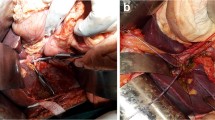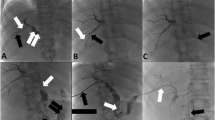Abstract
Background and aims
To evaluate treatment results in iatrogenic biliary injuries with concomitant vascular injuries.
Patients/Methods
Between January 1998 and May 2002 (inclusive), angiography was performed in 45 of the 105 patients treated for iatrogenic biliary tract injury. The charts of these 45 patients and 5 other patients in whom vascular injury was diagnosed at operation were evaluated retrospectively. Twenty-nine patients had concomitant vascular injury, the biliovascular injury group (BVI), and the remaining 21 patients had isolated biliary tract injury (IBTI).
Results
The most frequent initial operation was a cholecystectomy. The frequency of high-level (Bismuth III or IV) strictures was 90% in the BVI group and 62% in the IBTI group (P<0.05). Perioperative mortality was 7% in the BVI group and 5% in the IBTI group (P>0.05). The morbidity in the BVI group was significantly higher (P<0.05). Two patients in each group were lost to follow up. During a median (range) follow up of 31 months (5–51 months), a successful functional outcome was achieved in 96% of the BVI group and 100% of the IBTI group with a multimodal approach (P>0.05).
Conclusions
The frequency of high-level biliary injury and morbidity were significantly higher in the BVI group. However, concomitant vascular injury had no significant effect on mortality and medium-term outcome of biliary reconstruction. Thus, routine preoperative angiography is not recommended.
Similar content being viewed by others
References
Chapman WC, Halevy A, Blumgart LH, Benwamin IS (1995) Postcholecystectomy bile duct strictures: management and outcome in 130 patients. Arch Surg 130:597–604
Majno PE, Pretre R, Mentha G, Morel P (1996) Operative injury to the hepatic artery: consequences of a biliary-enteric anastomosis and principles for rational management. Arch Surg 131:211–215
Gupta N, Solomon H, Fairchild R, Kaminski DL (1998) Management and outcome of patients with combined bile duct and hepatic artery injuries. Arch Surg 133:176–181
Nishio H, Kamiya J, Nagino M, Katsuhiko U, Kanai M, Sano T, Hiramatsu K, Nimura Y (1999) Right hepatic lobectomy for bile duct injury associated with major vascular occlusion after laparoscopic cholecystectomy. J Hepatobiliary Pancreat Surg 6:427–430
Koffron A, Ferrario M, Parsons W, Nemcek A, Saker M, Abecassis (2001) Failed primary management of iatrogenic biliary injury: incidence and significance of concomitant hepatic arterial disruption. Surgery 130:722–731
Schmidt SC, Langrehr JM, Raakow R, Klupp J, Steinmüller T, Neuhaus P (2002) Right hepatic lobectomy for recurrent cholangitis after combined bile duct and right hepatic artery injury during laparoscopic cholecystectomy: a report of two cases. Langenbecks Arch Surg 387:183–187
Buell JF, Cronin DC, Funaki B, Koffron A, Yoshida A, Lo A, Leef J, Millis JM (2002) Devastating and fatal complications associated with combined vascular and bile duct injuries during cholecystectomy. Arch Surg 137:703–710
Nordin A, Makisolo H, Isoniemi H, Halme L, Lindgren L, Hockerstedt K (2001) Iatrogenic lesion at cholecystectomy resulting in liver transplantation. Transplant Proc 33:2499–2500
Siewert JR, Ungeheuer A, Feussner H (1994) Lesions of the common bile duct at laparoscopic cholecystectomy [in German]. Chirurg 65:748–757
Strasberg SM, Hertl M, Soper NJ (1995) An analysis of the problem of biliary injury during laparoscopic cholecystectomy. J Am Coll Surg 180:101–125
Halasz NA (1991) Cholecystectomy and hepatic artery injuries. Arch Surg 126:137–138
Stapleton GN, Hickman R, Terblanche J (1998) Blood supply of the right and left hepatic ducts. Br J Surg 85:202–207
Vellar I (1999) The blood supply of the biliary ductal system and its relevance to vasculobiliary injuries following cholecystectomy. Aust N Z J Surg 69:816–820
Bismuth H, Majno PE (2001) Biliary strictures: classification based on the principles of surgical management. World J Surg 25:1241–1244
Schweizer WP, Matthews JB, Baer HU, Nudelman LI, Triller J, Halter F, Gertsch P, Blumgart LH (1991) Combined surgical and interventional radiological approach for complex benign biliary obstruction. Br J Surg 78:559–563
Ahrendt SA, Pitt HA (2001) Surgical therapy of iatrogenic lesions of biliary tract. World J Surg 25:1360–1365
Author information
Authors and Affiliations
Corresponding author
Rights and permissions
About this article
Cite this article
Bilge, O., Bozkıran, S., Özden, İ. et al. The effect of concomitant vascular disruption in patients with iatrogenic biliary injuries. Langenbecks Arch Surg 388, 265–269 (2003). https://doi.org/10.1007/s00423-003-0382-6
Received:
Accepted:
Published:
Issue Date:
DOI: https://doi.org/10.1007/s00423-003-0382-6




